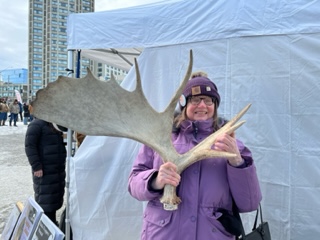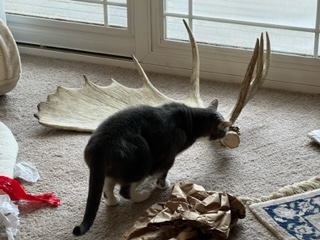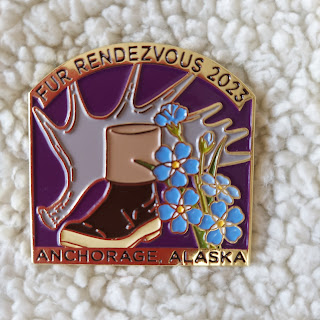Alaska has more earthquakes than any other state. I’ve felt one, back in the fall. It was hard and quick; my first thought was that a truck had hit the apartment. I said, “What the fudge,” or something similar, Grey was freaked, Sal was taking a shower and missed the whole thing. The 7.5 magnitude earthquake in Turkey and Syria has reminded me of the documentaries we’ve seen here on the 1964 Alaskan earthquake. There is an excellent movie on it at the Bureau of Land Management in Anchorage, and I was obsessed with firsthand recordings by survivors shown in a small museum in Seward. The personal recollections are incredibly sad and horrific, but it is a story worth sharing. I’ve researched more, and here’s what I’ve learned.
Alaska had almost 37,000 earthquakes last year. You can look at University of Alaska Fairbanks Alaska Earthquake Center site and see listing of the latest earthquakes in the state; today they seem to be happening every 15 to 30 minutes: 12:40, 12:13, 12:00, 11:46, etc. The majority of these register at magnitude 1 or less. The one I felt was a 4.9. Three in the last year have registered as greater than 6.

On March 27, 1964, Good Friday that year, at 5:36pm, without warning a 9.2 magnitude earthquake occurred, its epicenter 78 miles east of Anchorage. The earthquake, which lasted four minutes and thirty-eight seconds, remains the most powerful earthquake recorded in North American history and the second most powerful in world history since the development of seismographic measurements.* A fault between the Pacific and North American plates erupted in Prince William Sound. Six hundred miles of fault erupted at once, causing major structural destruction or damage to buildings and infrastructure. Just 30-40 miles southeast of Anchorage, areas near Girdwood and Portage on the Turnagain Arm dropped as much as eight feet. The communities were destroyed by subsidence and subsequent tidal damage. Girdwood was later relocated inland. Portage was abandoned. Two hundred miles southwest, near Kodiak, some areas were permanently raised by 30 feet.
Anchorage downtown was heavily damaged. Land overlooking the Ship Creek Valley, near the Alaska Railway yards, slid, causing destruction of many buildings and blocks of downtown. The Turnagain neighborhood, built on the bluffs of Cook Inlet, lost 75 homes to landslides. The area destroyed has now been turned into Earthquake Park. The 60 foot control tower at Anchorage International Airport collapsed.
Ocean floor shifts created tsunamis of up to 220 feet. Most coastal towns on the Prince William Sound, Kenai Peninsula and Kodiak Island area, especially the major ports of Seward, Whittier and Kodiak, were heavily damaged by a combination of seismic activity, subsidence, tsunamis and/or earthquake-related fires. When we visited Seward, we learned that an oil tanker was wrenched loose from a pipeline, which erupted in flames, which then spread to the other oil tanks. Burning oil on the water rushed through the town.
I see today the death toll in Turkey is over 20,000. Because Alaska was so less populated and the 1964 earthquake was at dinner time when most people were home, incredibly the death toll was only 128, including 16 from California and 4 children in Oregon who perished hours later from tidal waves. Only nine of the deaths were caused as a result of the earthquake itself. The vast majority were due to the resulting tsunamis, some of which hit shores less than 90 seconds after the shaking began. The first advisory from the Seismic Sea Wave Warning System indicating the possibility of a tsunami came 1-1/2 hours after the earthquake, long after the Alaskan communities had already been struck.
The Native Alutiiq village of Chenega on the Prince William Sound was the hardest hit in terms of percentage of population that perished. The death toll of 23 was a third of its residents. The people of Chenega were earthquake savvy. When the earth started shaking, they turned off their oil stoves and headed for higher ground. Parents told their older children to run up the mountain directly behind the village. Adults with babies and small children tried to carry them up the mountain but were quickly hit by the tsunami waves which pulled the children from their arms. Twelve of the 23 who died that day were children.
In Valdez, twenty-eight adults and children were on the dock watching the “M.V. Chena” unload its freight when the earthquake struck. The crew was happily throwing candy and oranges to the children watching. The earthquake quickly turned the glacial sediment along the waterfront into “liquid mud” and a huge section of it slid out into Port Valdez, displacing the water and collapsing the dock, warehouse, packing plant, cannery and bar. It also threw everyone from the dock down into the muddy ocean floor. Almost instantly, a 30 foot wave of mud and water rushed back into the waterfront, burying everything and everybody. The next 30 foot wave reached the business district of Valdez and damaged 40% of the businesses. The Union Oil tanks ruptured and caught fire. The entire town was damaged beyond repair in less than 10 minutes. Three years later, the town of Valdez was moved to a safer location four miles away.
Other coastal towns in the Pacific Northwest and Hawaii were damaged. A tsunami alert had been issued that day in Crescent City, California, but locals later said previous alerts had never materialized, so that warning was ignored. The 75 foot tidal wave leveled the town and caused 12 deaths.
Minor damage to boats occurred as far south as Los Angeles. Seiche waves, the sloshing of water back and forth in a small body of water like a swimming pool, were noted as far away as Texas and Louisiana. Oscillations in the height of water in wells were reported in countries around the world such as England, South Africa and Australia.
The Good Friday earthquake was a wake-up call for the United States, which recognized that had a similar-sized earthquake occurred in a major metropolitan area, the disaster would have been far worst in terms of fatalities and economic impact. Now, early earthquake warning systems are active around the world.
* The 1960 Valdivia earthquake, or the Great Chilean earthquake on May 22,1960, is the most powerful earthquake ever recorded. Various studies have placed it at 9.4-9.6 on the magnitude scale. It occurred in the afternoon and lasted for approximately 10 minutes.





.jpg)



%20(1).jpeg)
%20(2).jpeg)
%20(4).jpeg)














.jpg)

.jpg)
.jpeg)










.jpg)




.jpg)


.jpg)
